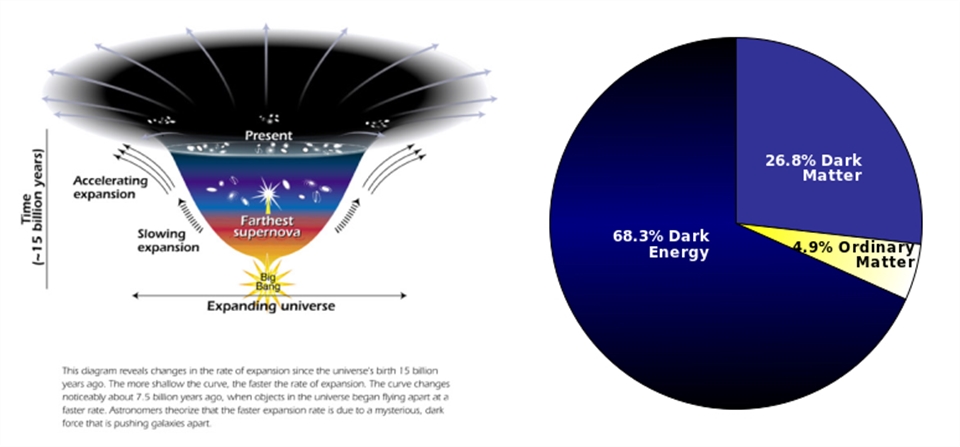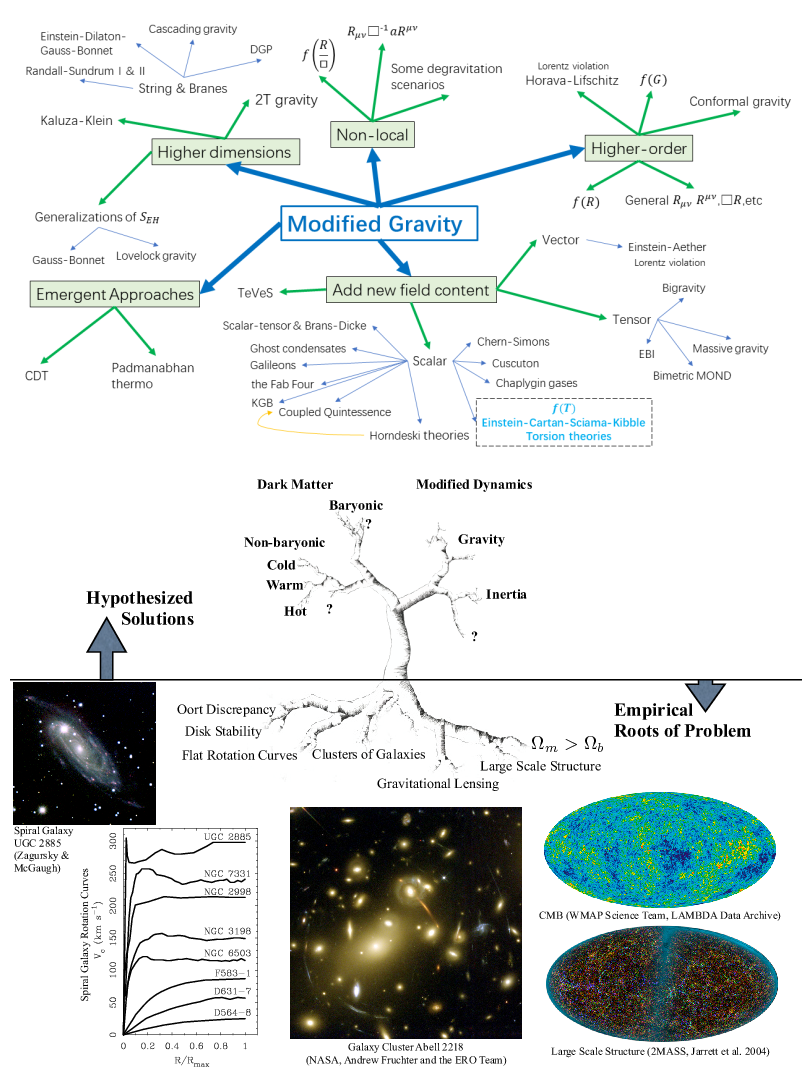Research Interest
Dark Energy
In modern cosmology, dark energy is a hypothetical energy form that is almost evenly distributed in everywhere of the universe and can drive a cosmic acceleration. However, it is extremely difficult to be detected directly. According to the standard LCDM model, dark energy accounts for about 70% of the entire universe and hence it can make a major contribution. There are currently many phenomenological models in explaining dark energy. The most representative and dramatic model is the cosmological constant that was introduced by Einstein when he studied the theory of general relativity. At that time, due to the technological limits of astronomical experiments, it was impossible for humans to know whether the universe was static or dynamic. He introduced a cosmological constant to yield a static cosmological solution. However, as Hubble discovered the expansion of the universe, Einstein soon abandoned this item and claimed that it was the biggest mistake in his life. Interestingly, a dramatic discovery was made in 1998, when two supernova observational teams independently found that our universe was accelerating, and then cosmologists picked up the cosmological constant from Einstein's trash box and used it to explain the observed phenomenon. However, since a cosmological constant is often interpreted as vacuum energy, it is difficult to extract suitable vacuum energy from quantum field theory that is consistent with current observations. Therefore, some alternative models of dark energy, such as Quintessence, Phantom, Quintom, Chameleons, as well as the Horndeski field and so on, were suggested by cosmologists under various physical motivations, and these models have made considerable progresses in current research.
Dark Matter
In modern cosmology, the Dark Universe accounts for about 95% of the entire universe. Except for dark energy, there exists another energy form, dubbed as dark matter, that is extremely difficult to be detected directly. Dark matter is hardly involved in any known electromagnetic, strong and weak interactions, and hence its detection is mainly through gravitational effects. As early as the 1930s, Fritz Zwicky used the Wiley theorem to infer that there might be invisible substances inside the constellation of the constellation, which is now called dark matter. More conclusive evidence comes from the long-term observations of the rotation curves of galaxies, in which a major contribution was made by the female astrophysicist Vera Rubin in the 1970s. In the era of modern astronomy dark matter can be detected via various experimental methods such as gravitational lensing, the large-scale structure survey, and cosmic microwave background radiations, which confirm that it accounts for about 25% of the entire universe. However, so far, the particle nature of dark matter remains a mystery. Although the prevailing viewpoint believes that dark matter is a kind of weakly interacting massive particles, major experimental efforts were made by various collaborations around the world and yet there is no conclusive evidence to prove its existence. In particular, considering that the sensitivities of these experiments have been very close to the background noise of solar neutrinos, it becomes very challenging for experimentalists to continue along this line. Instead, many other alternative models of dark matter were put forward and obtained more and more attention, namely, axions, primordial black holes and so on. The study of dark matter (as well as dark energy) is an important topic in the interdisciplinary field between modern cosmology and particle physics.
Inflation
As the standard model of modern cosmology, the hot big bang cosmology faces a series of conceptual issues, including: Why is the background universe highly isotropic? Why is the temperature of cosmic microwave background radiations so evenly distributed? Why is the space of the universe so flat? Why couldn't we observe monopoles that were predicted by many theories of particle physics? Where do the seeds of the large-scale structure formation arise from? To address these questions, Alan Guth proposed the theoretical scenario of inflationary cosmology in 1980. Interestingly, the very first inflation model was put forward in advance by Alexei Starobinsky, who applied a R^2 modification to GR in 1978, and remarkably it is so far one of the best models precisely consistent with the present cosmological observations. According to inflationary cosmology, our universe has experienced a dramatical acceleration within a short period of about 10^{-36}-10^{-32} seconds after the big bang, during which a unit space volume was enlarged by about 10^{78} times. During inflation, primordial density fluctuations can be quantum mechanically generated and soon become squeezed into classical perturbations, and therefore, inflationary cosmology provides a causal mechanism for the formation of the large-scale structure of the universe. Moreover, the spatial curvature and unwanted monopoles could be diluted by inflation and thus are not sensitive to current cosmological observations. However, since inflation is an effective point of view about the very early universe, there remain several conceptual issues. For example, it cannot explain the big bang singularity of the universe; the physical wavelength could have been even shorter than the Planck length at the beginning moment of inflationary phase; additionally, the microscopic interpretation of inflaton field remain a mystery. All these questions are core issues for the research of the very early universe.
Bounce
The standard model of modern cosmology, also known as the hot big bang cosmology, can be traced back to the 1940s and has achieved unprecedented successes in the understanding of the entire universe. However, both the big bang and its upgraded version, known as inflationary cosmology, face a severe problem, that is, our universe was born in a singularity of space and time about 13.8 billion years ago, which has failed to be explained by any known dictionaries of physics or mathematics. This means that big bang and inflation are incomplete theories: we don't know how the universe starts the evolution, nor what has happened before the singular beginning. In this context, a series of alternative theories appeared, among which the most representative one is bounce cosmology. In the picture of bounce cosmology, the universe has experienced a phase of contraction before the bounce, and its unit volume would become smaller and smaller until the universe evolved to a minimum size at a certain moment, and then bounced into the standard expansion of hot big bang. Consequently, bounce cosmology not only inherits the successes of the hot big bang cosmology, but also avoids the initial singularity issue. In this regard, it has further improved theoretical developments of the hot big bang cosmology. The research on bounce cosmology may be traced back to Tolman's works in the 1930s. However, the underlying perturbation theory and reasonable model constructions are still hot topics in modern cosmology.
Gravitational Theories Beyond Einstein
Since Einstein proposed general relativity in 1915, this theory about gravitation has soon become one of the cornerstones of modern physics. It successfully described all physics related to gravity from the microscopic atomic scale to the macroscopic solar system. However, along with the astronomical discoveries of abnormal rotation curves of galaxies and cosmic acceleration at present, the topic of gravitational theories beyond Einstein has become attractive to many physicists. A group of gravitational physicists believe that dark matter and dark energy may not necessarily exist. Instead, they expect to explain these observations by modifying GR on cosmological scales. On the other hand, from the theoretical aspect, physicists believe that a theory of gravitation should eventually accommodate with a reasonable quantum version. Although we are far away from a theory of quantum gravity, some modified gravity models that may present quantum effects can be developed in semi-classical level, namely, the R^2 inflation model. Moreover, the direct detection of gravitational waves was achieved by the LIGO collaboration in 2015. This great discovery announced the beginning of gravitational wave astronomy as well as gravitational wave cosmology that pushed the experimental tests of gravitational theories beyond Einstein into extremely high precision.
Cosmic Microwave Background
The cosmic microwave background (CMB) radiation is leftover radiation from Big Bang. When our Universe was born around 13.8 billion years ago, the temperature at that time is extremely high and the Universe is filled with hot plasma of particles (mostly protons, neutrons and electrons) and photons. As the Universe expanded and cooled, photons have been constantly interacting with plasma of particles until the first 380,000 years after Big Bang. And then, photons decoupled from the interaction with electrons and began to travel freely in the entire Universe till today, which is what we see today by COBE (Cosmic Background Explorer), WMAP (Wilkinson Microwave Anisotropy Probe) and Planck CMB detectors.
The CMB is the furthest back in time we can explore directly so far, and the physics at the time of the last scattering of photons and electrons imprinted in the map of CMB. The CMB is detected in all directions of the sky and appears to an almost uniform background with temperature about 2.73 Kelvin. Many tiny fluctuations in temperature have been also detected and these fluctuations relate to the differences in densities of structure, which probably seed galaxies later. By looking at the CMB, now we know that our Universe is indeed homogeneous and isotropic at large scales, and the parameters of standard model of cosmology have been measured with unprecedented levels of precision, and the theory of general relativity has been also rigorously tested. CMB can help us to explore what happened in the early stage of Universe and how the Universe evolved over billions of years.
Exploring New Physics Through Black Holes
Einstein’s general relativity is one of the cornerstones of modern physics. This elegant theory predicts “Matter tells spacetime how to curve and spacetime tells matter how to move”, which has passed the very strict test of experiments in the solar system. However, on the very large cosmological scale, the astronomical observation have shown that the standard general relativity needs to be modified in order to take the accelerating expansion of the universe into considerations. An interesting question is whether the standard general relativity also needs to be modified for extremely small scales, especially for the extremely strong gravitational fields near the event horizon of a black hole. Recent advances in gravitational waves and radio astronomy have set the stage for answering this question. For example, the Laser Interferometer Gravitational Wave Observatory (LIGO) and other current or future gravitational wave experiments such as VIRGO, Tianqin and LISA allow us to receive gravitational wave signals from the merger of two black holes, which carries the information about the gravitational field around this binary system to tell us if the standard general relativity still holds. Another progress on this topic is the first black hole photo taken by the Event Horizon Telescope (EHT), which has led to the insight into how light near the event horizon of black holes moves and what the gravitational field near the event horizon of black holes looks like. As a result, these new probes could let us explore the possible new physics beyond Einstein’s general relativity that only happens in the extremely strong gravitational field.






